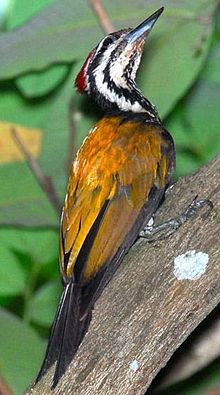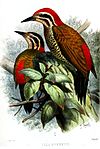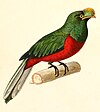Dinopium
Appearance
| Flamebacks | |
|---|---|

| |
| Common flameback (Dinopium javanense) | |
| Scientific classification | |
| Domain: | Eukaryota |
| Kingdom: | Animalia |
| Phylum: | Chordata |
| Class: | Aves |
| Order: | Piciformes |
| Family: | Picidae |
| Tribe: | Picini |
| Genus: | Dinopium Rafinesque,1814 |
| Type species | |
| Dinopium (Picoides) erythronotus[1] Rafinesque, 1814
| |
| Species | |
|
see text | |
Dinopiumis agenusof birds in the woodpecker familyPicidae.The species are found inSouthandSoutheast Asia.
The genus was introduced by the FrenchpolymathConstantine Samuel Rafinesquein 1814 to accommodate thecommon flameback(Dinopium javanense).[2][3]The name combines theClassical Greekdeinosmeaning "mighty" or "huge" andōps/ōposmeaning "appearance".[4]
A large phylogenetic study of the woodpecker family Picidae published in 2017 found that the genus wasparaphyletic.The olive-backed woodpecker (Dinopium rafflesii) is more closely related to thepale-headed woodpecker(Gecinulus grantia) than it is to other members of the genusDinopium.[5]
Species
[edit]As presently constituted, the genus contains the following 5 species:[6]
| Image | Scientific name | Common Name | Distribution |
|---|---|---|---|
 |
Dinopium shorii | Himalayan flameback | Bangladesh, Bhutan, India, Myanmar, and Nepal |
 |
Dinopium javanense | Common flameback | Bangladesh, Brunei, Cambodia, China, India, Indonesia, Laos, Malaysia, Myanmar, Singapore, Thailand, and Vietnam |

|
Dinopium everetti | Spot-throated flameback | island of Palawan in the Philippines. |
 |
Dinopium benghalense | Black-rumped flameback | Pakistan, India south of the Himalayas and east till the western Assam valley and Meghalaya, Bangladesh and Sri Lanka |

|
Dinopium psarodes | Red-backed flameback | Sri Lanka |
References
[edit]- ^"Picidae".aviansystematics.org.The Trust for Avian Systematics.Retrieved2023-07-26.
- ^Rafinesque, Constantine Samuel(1814).Principes Fondamentaux de Somiologie(in French). Palerme. Inside front cover.
- ^Peters, James Lee,ed. (1948).Check-List of Birds of the World.Vol. 6. Cambridge, Massachusetts: Harvard University Press. p. 143.
- ^Jobling, James A. (2010).The Helm Dictionary of Scientific Bird Names.London: Christopher Helm. p. 136.ISBN978-1-4081-2501-4.
- ^Shakya, S.B.; Fuchs, J.; Pons, J.-M.; Sheldon, F.H. (2017)."Tapping the woodpecker tree for evolutionary insight".Molecular Phylogenetics and Evolution.116:182–191.Bibcode:2017MolPE.116..182S.doi:10.1016/j.ympev.2017.09.005.PMID28890006.
- ^Gill, Frank;Donsker, David;Rasmussen, Pamela,eds. (2020)."Woodpeckers".IOC World Bird List Version 10.1.International Ornithologists' Union.Retrieved17 May2020.








